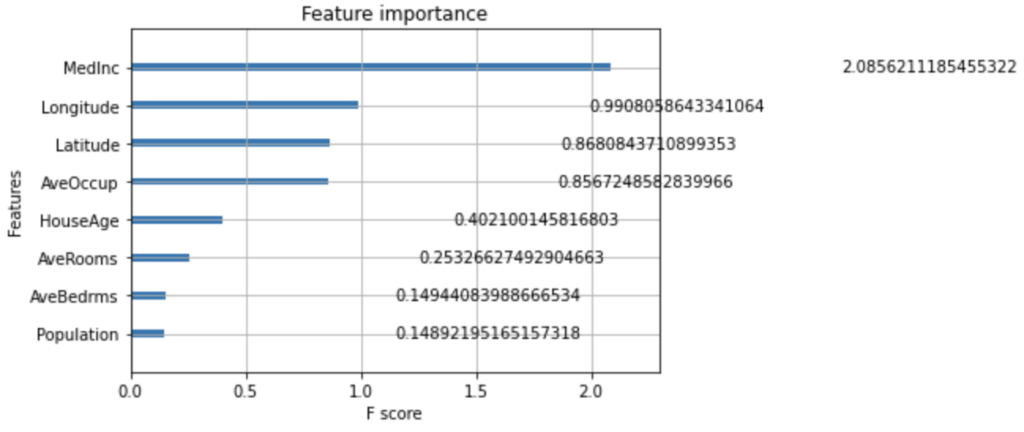Python – XGBoostで回帰分析(XGBoost API)
今回は業務にて非常に使用する機会の多い、Python – XGBoostで回帰分析(XGBoost API)について記載していこうと思います。最近では、Causal Inferenceのmodelでもかなり頻繁に使用する機会が多いのではないでしょうか。そこで、今回は回帰/Regressionについて記載していきます。
Scikit-learn APIのXGBoostは以下をご参照ください。
1. データ準備
データ準備として、今回はsklearn.datasetsのcalifornia_housingを使用していきます。このデータは回帰用のSampleデータとして使用できますので、必要に応じて使用してみてください。また、pandas.dataframeを使用するので、pandasもimportし、sklearn.datasetsのcalifornia_housingのデータをpandas.dataframeに格納します。
In [1]: import pandas as pd
...: from sklearn.datasets import fetch_california_housing
In [2]: california_housing = fetch_california_housing()
...: df = pd.DataFrame(california_housing.data, columns=california_housing.feature_names)
...: df.head()
Out[2]:
MedInc HouseAge AveRooms AveBedrms Population AveOccup Latitude Longitude
0 8.3252 41.0 6.984127 1.023810 322.0 2.555556 37.88 -122.23
1 8.3014 21.0 6.238137 0.971880 2401.0 2.109842 37.86 -122.22
2 7.2574 52.0 8.288136 1.073446 496.0 2.802260 37.85 -122.24
3 5.6431 52.0 5.817352 1.073059 558.0 2.547945 37.85 -122.25
4 3.8462 52.0 6.281853 1.081081 565.0 2.181467 37.85 -122.25california_housingのtargetデータ「MudHouseVal」をpandas.dataframeに追加してデータ準備完了です。
In [3]: df['MedHouseVal'] = pd.Series(california_housing.target)
...: df.head()
Out[3]:
MedInc HouseAge AveRooms AveBedrms Population AveOccup Latitude Longitude MedHouseVal
0 8.3252 41.0 6.984127 1.023810 322.0 2.555556 37.88 -122.23 4.526
1 8.3014 21.0 6.238137 0.971880 2401.0 2.109842 37.86 -122.22 3.585
2 7.2574 52.0 8.288136 1.073446 496.0 2.802260 37.85 -122.24 3.521
3 5.6431 52.0 5.817352 1.073059 558.0 2.547945 37.85 -122.25 3.413
4 3.8462 52.0 6.281853 1.081081 565.0 2.181467 37.85 -122.25 3.422以上でデータ準備は完了です。
2. Training / Validationデータ作成
では、TrainingデータとValidationデータを作成して、modelingの準備をしていこうと思います。
念の為、TargetデータにNaNが存在するかを確認してみます。
In [4]: df['MedHouseVal'].isnull().sum()
Out[4]:
0特に前処理の必要はなさそうなので、そのまま変数yに代入していきます。
In [5]: y = df['MedHouseVal']次に、Feature setを変数Xに格納し、各カラムの要約統計量を確認してみます。
In [6]: X = df.drop('MedHouseVal', axis=1)
...: X.describe()
Out[6]:
MedInc HouseAge AveRooms AveBedrms Population AveOccup Latitude Longitude
count 20640.000000 20640.000000 20640.000000 20640.000000 20640.000000 20640.000000 20640.000000 20640.000000
mean 3.870671 28.639486 5.429000 1.096675 1425.476744 3.070655 35.631861 -119.569704
std 1.899822 12.585558 2.474173 0.473911 1132.462122 10.386050 2.135952 2.003532
min 0.499900 1.000000 0.846154 0.333333 3.000000 0.692308 32.540000 -124.350000
25% 2.563400 18.000000 4.440716 1.006079 787.000000 2.429741 33.930000 -121.800000
50% 3.534800 29.000000 5.229129 1.048780 1166.000000 2.818116 34.260000 -118.490000
75% 4.743250 37.000000 6.052381 1.099526 1725.000000 3.282261 37.710000 -118.010000
max 15.000100 52.000000 141.909091 34.066667 35682.000000 1243.333333 41.950000 -114.310000また、Nullチェックも行います。
In [7]: X.isnull().sum()
Out[7]:
MedInc 0
HouseAge 0
AveRooms 0
AveBedrms 0
Population 0
AveOccup 0
Latitude 0
Longitude 0
dtype: int64Nullもなさそうなので、Training / Validationデータを作成していきます。
In [8]: from sklearn.model_selection import train_test_split
...:
...: X_train, X_test, y_train, y_test = train_test_split(X, y, test_size=0.3, random_state=0)今回は、7:3で作成していますが、業務に合わせて適宜変更することが必要だと思います。
3. XGBoostで回帰分析(XGBoost API)
それでは、本題の回帰分析を行なっていこうと思います。XGBoost APIのtrain()で回帰分析を行なってみます。scikit-learnでの回帰分析は別の記事にて行なってみようと思います。
3-1. DMatrix、Train実施
では、XGBoost APIでTrainingを行なってみます。まず、Core Data Structureにデータをセットしていきます。以下API docです。
https://xgboost.readthedocs.io/en/stable/python/python_api.html#module-xgboost.core
次に、XGBoostのLearning APIでtrainingを行います。また、精度向上のために、early stoppingを1000で実行していきます。なお、evaluation metricはRMSEを使用します。
https://xgboost.readthedocs.io/en/stable/python/python_api.html#module-xgboost.training
In [10]: from xgboost import DMatrix, train
...:
...: dtrain = DMatrix(X_train, label=y_train)
...: dtest = DMatrix(X_test, label=y_test)
...:
...: xgb_params = {
...: 'eval_metric': 'rmse',
...: }
...:
...: evals = [(dtrain, 'train'), (dtest, 'eval')]
...:
...: evals_result = {}
...: model = train(
...: xgb_params,
...: dtrain,
...: num_boost_round=1000,
...: evals=evals,
...: evals_result=evals_result,
...: verbose_eval = 100
...: )
[0] train-rmse:1.44495 eval-rmse:1.45025
[100] train-rmse:0.26120 eval-rmse:0.47802
[200] train-rmse:0.19185 eval-rmse:0.47662
[300] train-rmse:0.14826 eval-rmse:0.47655
[400] train-rmse:0.11905 eval-rmse:0.47565
[500] train-rmse:0.09425 eval-rmse:0.47566
[600] train-rmse:0.07563 eval-rmse:0.47566
[700] train-rmse:0.05981 eval-rmse:0.47586
[800] train-rmse:0.04899 eval-rmse:0.47608
[900] train-rmse:0.04038 eval-rmse:0.47636
[999] train-rmse:0.03356 eval-rmse:0.476333-2. Early stoppingの学習状況
学習状況をplotしてみます。
In [11]: import matplotlib.pyplot as plt
...:
...: train_metric = evals_result['train']['rmse']
...: plt.plot(train_metric, label='train rmse')
...: eval_metric = evals_result['eval']['rmse']
...: plt.plot(eval_metric, label='eval rmse')
...: plt.grid()
...: plt.legend()
...: plt.xlabel('rounds')
...: plt.ylabel('rmse')
...: plt.show()
3-3. Prediction / Validation
では、Validationを行うために、validationデータを使用してPredictionを行い、Validation Scoreとして今回はRMSEを確認してみます。
In [12]: import numpy as np
...: from sklearn.metrics import mean_squared_error
...:
...: y_pred = model.predict(dtest)
...:
...: rmse = np.sqrt(mean_squared_error(y_test, y_pred))
...: print("RMSE : % f" %(rmse))
RMSE : 0.476332Scatter plotを使用して分析結果を確認してみます。
In [13]: import matplotlib.pyplot as plt
...:
...: plt.scatter(y_test, y_pred, alpha=0.5)
...: plt.xlabel('ground truth')
...: plt.ylabel('prediction')
...: plt.show()
Outlierが存在するかもしれませんね。業務であれば、Outlierを除外するかそのまま含めるかを判断しますが、今回はそのまま含めていきます。
3-4. Feature Importance
では、Feature Importanceも確認していきます。
In [15]: from xgboost import plot_importance
...:
...: plot_importance(model)
...: plt.show()
今回はWeightですが、MedIncが一番多く使用されているようです。次は、Gainも確認してみようと思います。
In [16]: plot_importance(model, importance_type = "gain")
...: plt.show()
やはり、MedIncがKey featureなのかもしれません。
4. まとめ
ということで、今回は「Python – XGBoostで回帰分析(XGBoost API)」について記載してみました。ただ、Causal Machine Learning特にEcomMLでは、scikit-learnのXGBoostを使用する必要もあったので、次回はscikit-learnで回帰分析を行なってみようと思います。